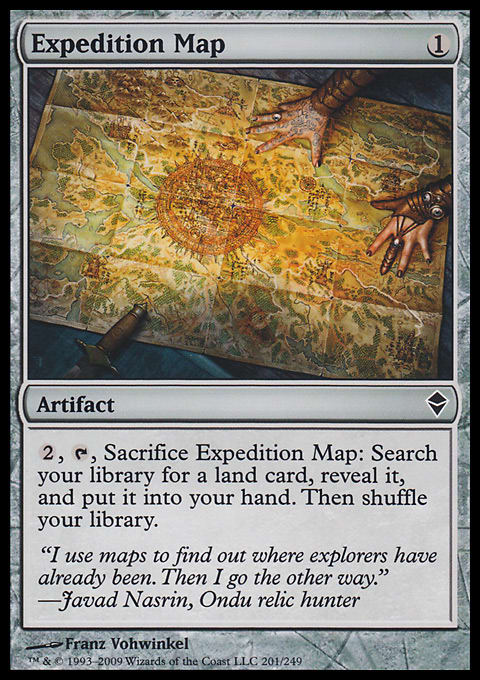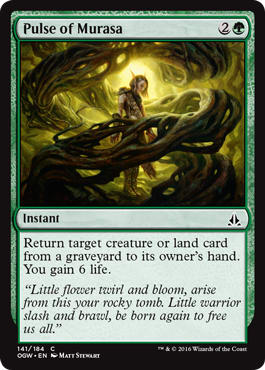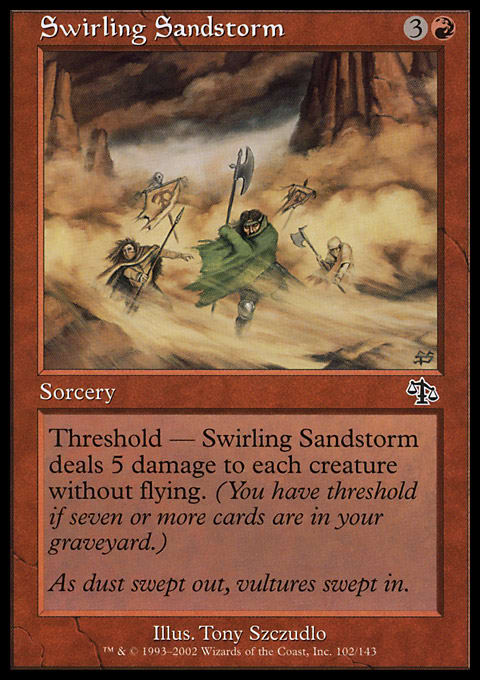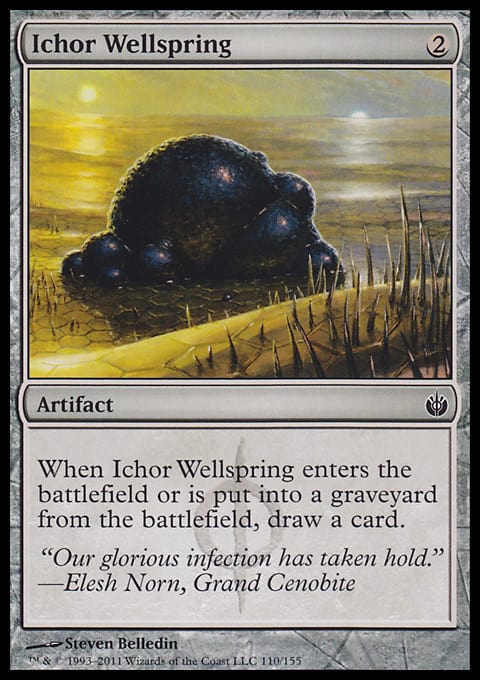It is an interesting time in Pauper. Due to the recent shake up it is almost as if three new sets — Eternal Masters, Eldritch Moon, and Kaladesh — were released all at once. Such bounties are rare indeed and to say that the metagame looks drastically different would be underselling it quite a bit.
The old decks are still good. Delver, Affinity, and Stompy remain strong options and Tron has reemerged as a contender.
Tron is the current holder of the big mana crown. Formerly crowded out by Peregrine Drake decks, the old stalwart is back in business.
Tron ? Pauper| Bitmaximus, 5-0 Pauper League, November 23, 2016
- Creatures (13)
- 2 Ulamog's Crusher
- 3 Sea Gate Oracle
- 4 Fangren Marauder
- 4 Mulldrifter
- Spells (30)
- 2 Pulse of Murasa
- 2 Chainer's Edict
- 2 Firebolt
- 2 Rolling Thunder
- 4 Ancient Stirrings
- 2 Prismatic Lens
- 4 Chromatic Sphere
- 4 Chromatic Star
- 4 Expedition Map
- 4 Prophetic Prism
- Lands (17)
- 1 Shimmering Grotto
- 1 Unknown Shores
- 3 Haunted Fengraf
- 4 Urza's Mine
- 4 Urza's Power Plant
- 4 Urza's Tower
- Sideboard (15)
- 2 Circle of Protection Green
- 3 Circle of Protection Red
- 2 Evincar's Justice
- 2 Gorilla Shaman
- 2 Journey to Nowhere
- 3 Pyroblast
- 1 Ray of Revelation
Tron is capable of overpowering other strategies provided the pieces fall correctly. The ability to go from a position of mana screw to one of abundance in the blink of eye is potent. To achieve this Tron needs to dedicate an inordinate number of slots to ensure it can cast key spells. Expedition Map is a given but cards like Chromatic Sphere and Chromatic Star help to increase the number of cards seen while also providing correct mana. Prophetic Prism serves a similar function while having the good sense to stick on the board. Prismatic Lens is a newer addition to the deck (coming into vogue shortly before Shadows over Innistrad) that helps to jump the curve to eight (AKA Ulamog's Crusher mana) while also providing scarce discrete mana.
Tron thrives on the back of its haymakers. Sea Gate Oracle is a glue card — it holds the line as a blocker while filtering draws towards the best card. Mulldrifter can cement card advantage while Fangren Marauder tussles with just about everything in the format while also gaining obscene amounts of life. Marauder is key to the deck as it provides a safety net for taking off the first few turns of the game. Rounding out the top end are copies of Ulamog's Crusher and Rolling Thunder as ways to slam the door.
Tron decks feature variable removal suites that tend to focus on spells with inherent card advantage a la Firebolt and Chainer's Edict. Pulse of Murasa is becoming a more common inclusion for its ability to buff a life total while also retrieving a key piece of the puzzle. Condescend has also seen more play as another mana sink that helps to sculpt draws. Both of these cards play a key role in Murasa Tron — a base Izzet control deck that uses the Tron engine for an endgame.
Murasa Tron ? Pauper | menglong, 5-0 Pauper League, November 17, 2016
- Creatures (9)
- 2 Mnemonic Wall
- 3 Sea Gate Oracle
- 4 Mulldrifter
- Spells (28)
- 1 Capsize
- 1 Counterspell
- 1 Echoing Truth
- 1 Exclude
- 1 Ghostly Flicker
- 1 Twin Bolt
- 2 Condescend
- 2 Lightning Bolt
- 2 Mana Leak
- 2 Mystical Teachings
- 2 Pulse of Murasa
- 1 Rolling Thunder
- 2 Chainer's Edict
- 2 Compulsive Research
- 3 Flame Slash
- 4 Prophetic Prism
- Lands (23)
- 2 Island
- 1 Dismal Backwater
- 1 Thornwood Falls
- 1 Unknown Shores
- 2 Shimmering Grotto
- 4 Swiftwater Cliffs
- 4 Urza's Mine
- 4 Urza's Power Plant
- 4 Urza's Tower
- Sideboard (15)
- 1 Pulse of Murasa
- 1 Ancient Grudge
- 1 Dispel
- 2 Electrickery
- 2 Hydroblast
- 2 Magma Spray
- 2 Negate
- 3 Pyroblast
- 1 Ulamog's Crusher
The Murasa variant is a more consistent deck as it has more lands and can function even when Tron is not online. But it is built to win the long game and with decks like traditional Tron and others present trying to go long is a tough prospect. It is not that these decks cannot succeed but rather it is harder to see the fruits of their labor. A deck like Murasa Tron can be finely tuned to beat a large number of matchups but it cannot beat everything. All it takes is for one aggressive deck to pop up that the Murasa deck has opted to ignore and suddenly that pristine record is out the window.
Compare this to traditional Tron which simply tries to go over the top of adversaries. Such a strategy makes for more 5-0 appearances as it as many decks simply fold to the combination of Fangren Marauder and artifacts going to the graveyard. That makes up for some very shaky construction as many Tron decks have completely ignored lands that natural produce colors of mana in favor of Shimmering Grotto and Haunted Fengraf. The Fengraf helps to obsolete removal but forces the deck to lean more on key artifacts. It is this all in nature that highlights a vulnerability. Attacking lands is not the way to beat this deck but attacking its threats and sources of specific mana. Without Prisms and Lenses Tron can struggle in resolving spells. Exhausting these resources while also dealing with creatures is challenging but can be done.
The rise of Tron and aggressive decks highlights an important exclusion from Pauper — sweepers. Decks relying on creatures surviving late into a game have an increased vulnerability in other formats thanks to various board wipes. Pauper has very few of these cards and they are all highly conditional. Electrickery and Evincar's Justice both see heavy play but do little against larger threats. Crypt Rats has seen a surge in popularity while Claws of Wirewood is a non-factor. Fade Away, Holy Light, Sandstorm, and Shrivel are all sideboard all-stars. The last one, however, is a bit more obscure.
Swirling Sandstorm demands attention. The ability to take down almost every non-flying threat (yes, we see you Gearseeker Serpent) warrants further examination. The condition — Threshold — is not a given in a format where Bojuka Bog and Relic of Progenitus see significant play but the payoff is massive. Stompy, Red Deck Wins, Affinity, Tron, Elves, and more — they all commit threats to the board. Swirling Sandstorm can be source of card advantage when “on”. The best home for the Judgment common may be a R/B removal heavy deck that uses Faithless Looting and Cathartic Reunion to fill the graveyard with payoff cards like Ghoulcaller's Accomplice and Undead Servant. Following up a wipe with an army of Zombie tokens seems like a decent play and could provide another wrinkle to the metagame.
What else is out there? Rally the Peasants was shifted to common in Eternal Masters and saw some play in token heavy builds before being crowded out of the format. The past week has seen a hybrid Boros Midrange — Tokens deck that leans heavily on Kuldotha Rebirth to help generate an army. Kuldotha Tokens takes Boros Midrange and gives it a more aggressive bend.
Kuldotha Tokens ? Pauper | madarameBK, 5-0 Pauper League, November 23, 2016
- Creatures (11)
- 3 Thraben Inspector
- 4 Glint Hawk
- 4 Kor Skyfisher
- Spells (28)
- 2 Rally the Peasants
- 4 Galvanic Blast
- 4 Lightning Bolt
- 2 Firebolt
- 3 Battle Screech
- 3 Kuldotha Rebirth
- 2 Journey to Nowhere
- 4 Ichor Wellspring
- 4 Prophetic Prism
- Lands (21)
- 1 Mountain
- 1 Plains
- 1 Forgotten Cave
- 2 Boros Garrison
- 2 Radiant Fountain
- 2 Secluded Steppe
- 4 Wind-Scarred Crag
- 4 Ancient Den
- 4 Great Furnace
- Sideboard (15)
- 2 Circle of Protection Red
- 2 Electrickery
- 2 Gorilla Shaman
- 3 Molten Rain
- 3 Pyroblast
- 3 Standard Bearer
I have been of the mindset that both Boros and Jeskai Midrange are slow burn decks. They manipulate cards like Ichor Wellspring with Glint Hawk and Kor Skyfisher to draw into Lightning Bolts and Galvanic Blasts. These cards coupled with the moderate air force can end a game in short order. Kuldotha Tokens operates with a similar engine but has a far more aggressive endgame. Utilizing Battle Screech and Kuldotha Rebirth the deck is able to turn on a dime and win with Rally the Peasants.
Despite not having access to Blue, Kuldotha Tokens has a surprising amount of card advantage. Firebolt, Battle Screech, and Rally the Peasants all have Flashback. Battle Screech and Kuldotha Rebirth both produce multiple creatures and even though Rebirth has a drawback it is mitigated thanks to how important the bodies are to Rally.
In my experience Kuldotha Tokens shifts from midrange to combo the turn before it tries to win. Tapping out for Battle Screech at a high enough life total means that a likely lethal Rally is coming soon. The fact that the anthem effect can add four points of power in a single turn gives Tokens a far more explosive bit of reach than a card like Guardians' Pledge in Mono-White builds. The fact that this build can produce two colors of tokens is important in that it helps to reduce the efficacy of a commonly played Fog effect in Prismatic Strands.
At its core Kuldotha Tokens is still an aggressive deck that can be attacked with many of the same board wipes mentioned earlier. Echoing Decay and Wail of the Nim have increased utility in this matchup and they pair rather well with other Black removal at taking out the more robust creatures.
Speaking of Black removal, Chainer's Edict is back with a vengeance. While never a bad card it definitely struggled in world where one-for-one trades would leave you significantly behind. Now that the format has shifted to a place where these trades are far more reasonable Black-based control decks can once again make their mark.
Mono-Black Control ? Pauper | lupi, 5-0 Pauper League, November 23, 2016
- Creatures (19)
- 1 Okiba-Gang Shinobi
- 2 Gurmag Angler
- 4 Chittering Rats
- 4 Cuombajj Witches
- 4 Gray Merchant of Asphodel
- 4 Phyrexian Rager
- Spells (19)
- 2 Disfigure
- 2 Victim of Night
- 3 Tendrils of Corruption
- 2 Sign in Blood
- 2 Unearth
- 4 Chainer's Edict
- 4 Night's Whisper
- Lands (22)
- 19 Swamp
- 3 Barren Moor
- Sideboard (13)
- 4 Choking Sands
- 1 Crypt Rats
- 1 Death Denied
- 2 Geth's Verdict
- 2 Nihil Spellbomb
- 3 Wrench Mind
Mono-Black Control ? Pauper| Andor2, 5-0 Pauper League November 24, 2016
- Creatures (18)
- 1 Crypt Rats
- 2 Gurmag Angler
- 3 Liliana's Specter
- 4 Chittering Rats
- 4 Cuombajj Witches
- 4 Phyrexian Rager
- Spells (19)
- 2 Geth's Verdict
- 2 Victim of Night
- 3 Disfigure
- 3 Tendrils of Corruption
- 1 Corrupt
- 2 Sign in Blood
- 2 Unearth
- 4 Chainer's Edict
- Lands (23)
- 20 Swamp
- 1 Bojuka Bog
- 2 Barren Moor
- Sideboard (15)
- 1 Crypt Rats
- 2 Distress
- 4 Duress
- 1 Grim Harvest
- 2 Icequake
- 2 Okiba-Gang Shinobi
- 2 Relic of Progenitus
- 1 Shrivel
The goal of Mono-Black Control is to contain threats while gaining incremental advantage. Eventually enough resources will be accrued to turn the previous turns into a stepping stone toward victory. The above decks go about this progression in slightly different ways. Lupi runs along the old road of building up Devotion for a Gray Merchant of Asphodel payoff while Andor2 eschews the Theros staple for a single copy of Corrupt and enough life gain to make a Crypt Rats slanted Fireball viable. Both decks are heavy on removal which help to keep the paths clear for their army of 2/2s.
Black decks tend to struggle when creatures can dodge removal. Young Wolf and Stormbound Geist are problematic while Battle Screech can often provide enough defense from a Chainer's Edict that other creatures are able to get the job done. Mono-Black decks also struggle when their removal matches up poorly with the rest of the field — Gurmag Angler is one of the best threats to fight Black since both Doom Blade and Victim of Night are useless against the Zombie Fish. All that said Black based control decks are tracking at around 5% of the undefeated metagame so far as opposed to 1.1% in the pre-ban world.
Murasa Black ? Pauper| Sixes, 5-0 Pauper League, November 24, 2016
- Creatures (19)
- 2 Crypt Rats
- 2 Gurmag Angler
- 2 Penumbra Spider
- 3 Cuombajj Witches
- 3 Phyrexian Rager
- 3 Thraben Foulbloods
- 4 Chittering Rats
- Spells (19)
- 1 Death Denied
- 1 Doom Blade
- 1 Echoing Decay
- 1 Victim of Night
- 3 Pulse of Murasa
- 2 Unearth
- 3 Chainer's Edict
- 3 Dead Weight
- 4 Metalspinner's Puzzleknot
- Lands (22)
- 2 Forest
- 8 Swamp
- 1 Bojuka Bog
- 1 Tranquil Thicket
- 2 Barren Moor
- 2 Evolving Wilds
- 2 Golgari Rot Farm
- 4 Jungle Hollow
- Sideboard (15)
- 1 Doom Blade
- 1 Pulse of Murasa
- 1 Victim of Night
- 3 Duress
- 2 Nausea
- 2 Relic of Progenitus
- 2 Tangle
- 3 Wickerbough Elder
One of these is this version of Murasa Black. Another deck built around Chainer's Edict, Murasa Black avoids Devotion in favor of increasing the grind with Pulse of Murasa to boost life and getting back a creature which can lead to even more incremental advantages. The above list also uses Thraben Foulbloods as a way to close out games. To facilitate this the deck also runs Dead Weight and Metalspinner's Puzzleknot to fuel Delirium. A single copy of Death Denied serves as a way to “draw” multiple cards in the middle stages of the game, often cementing victory by a thousand cuts.
Pauper is currently experiencing an uptick in variety. The ban of Peregrine Drake has opened up the possibilities from old standards to new builds. And I have a feeling we have only begun to scratch the surface. With Aether Revolt almost two months away we are going to have plenty of time to explore this old new world of Pauper.


























